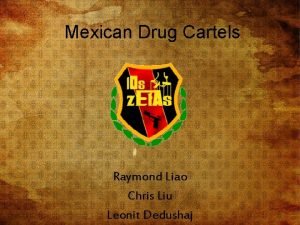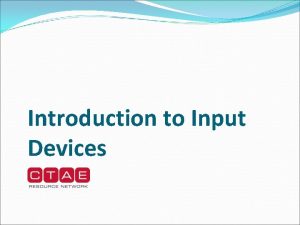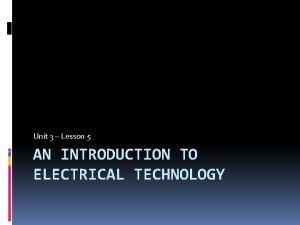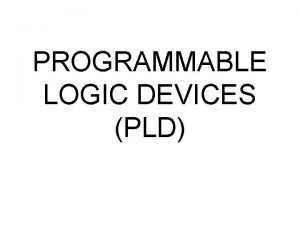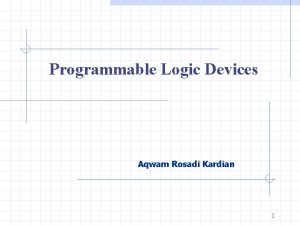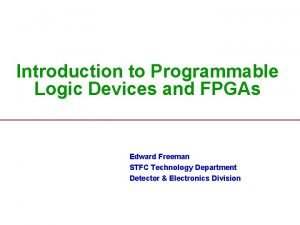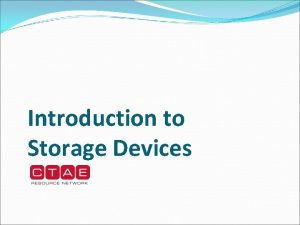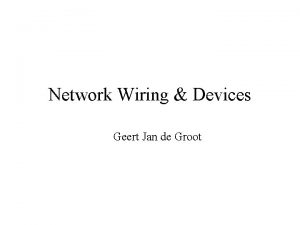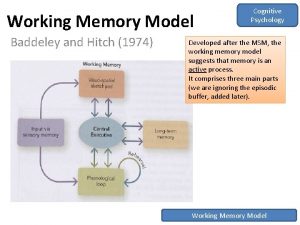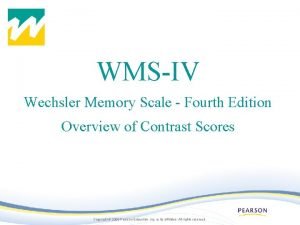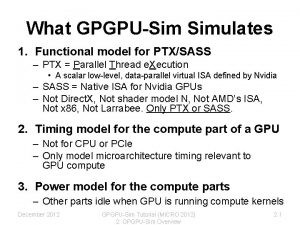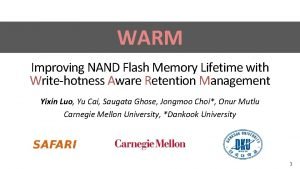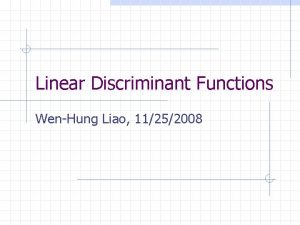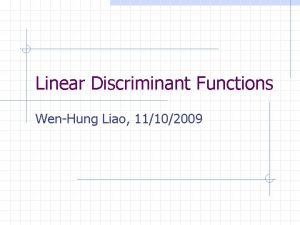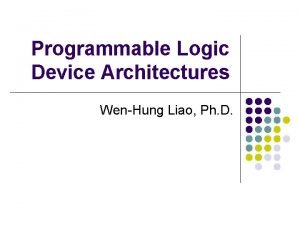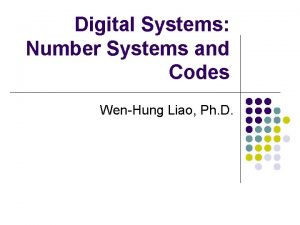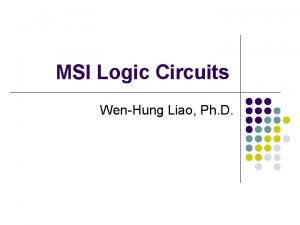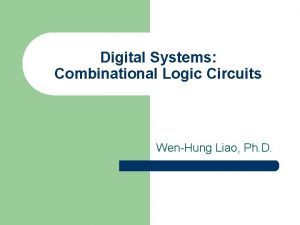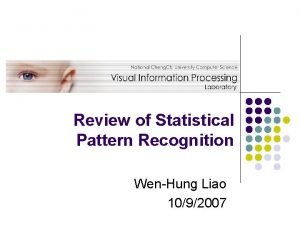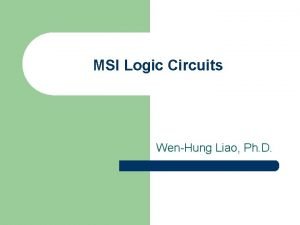Memory Devices WenHung Liao Ph D Introduction l












































- Slides: 44

Memory Devices Wen-Hung Liao, Ph. D.

Introduction l Main memory vs. auxiliary memory

Memory Terminology l l l Memory cell: a device used to store a single bit (0 or 1). Examples: FF, charged capacitor, a single spot on a magnetic disk or tape. Memory word: a group of bits (cells) in a memory that represents instructions or data of some type. Byte: a special term used for a group of 8 bits. Capacity: a way of specifying how many bits of data can be stored in a particular memory device. Example: 4096 20 -bit words = 4 K x 20 Density: another term for capacity. Often with reference to space.

Memory Terminology(cont’d) l l l Address: A number that identifies the location of a word in memory. (Figure 12 -2) Read operation: the operation whereby the binary word stored in a specific memory location is sensed and then transferred to another device. Write operation: the operation whereby a new word is placed into a particular memory location. Access time: amount of time required to perform a read operation. Volatile memory: any type of memory that requires the application of electrical power in order to store information.

Fig. 12 -2: Memory Addresses

Memory Terminology (cont’d) l l Random Access Memory (RAM): memory in which the actual physical location of memory word has no effect on how long it takes to read from or write into that location. Sequential Access Memory: a type of memory in which the access time is not constant but varies depending on the address location. Read/Write Memory: any memory that can be read from and written into with equal ease. Read-Only Memory(ROM)

Memory Terminology (cont’d) l l Static memory devices: semiconductor memory devices in which the stored data will remain permanently stored as long as power is applied. Dynamic memory devices: data need to be periodically refreshed. Main memory: also referred to as the computer’s working memory. Auxiliary memory: also referred to as mass storage. Always nonvolatile.

General Memory Operation l l l Select the address in memory that is being accessed for a read or write operation. Select either a read or a write operation to be performed. Supply the input data to be stored in memory during a write operation. Hold the output data coming from memory during a read operation. Enable (or disable) the memory so that it will (or will not) respond to the address inputs and read/write command.

Address Inputs l l l N words log 2 N address inputs The R/W’ input Memory Enable: Chip Enable, Chip Select

CPU-Memory Connections l l l Address Bus: a unidirectional bus that carries the binary outputs from the CPU to the memory IC to select one memory location. Data Bus: a bi-directional bus that carries data between the CPU and the memory IC. Control bus: carries control signals from the CPU to the memory IC.

Read-Only Memory l l Designed to hold data that either are permanent or will not change frequently. During normal operation, no data can be written into a ROM, but data can be read from ROM. The process of entering data is called programming or burning-in the ROM. All ROMs are nonvolatile.

ROM Block Diagram l l Figure 12 -6 shows a 16 x 8 ROM. 4 address inputs, 8 data outputs. CS: Chip Select. The Read operation.

ROM Architecture l l l Figure 12 -7: architecture of a 16 x 8 ROM. Register array Row decoder Column decoder Output buffers.


ROM Timing l l t. ACC: access time, time interval between the application of a ROM’s input and the appearance of the data outputs during a read operation. t. OE: output enable time, the delay between the CS input and the valid data output.

Types of ROMs l l l Mask-Programmed ROM: cannot be reprogrammed (Figure 12 -9). Programmable ROMs (PROMs): Figure 12 -11. Erasable Programmable ROM (EPROM): use UV lights to erase all cells at the same time. (15 -20 minutes. ) Vpp: programming voltage. Figure 12 -12. Electrically Erasable PROM (EEPROM): Figure 1213, allows rapid in-circuit erasure and reprogramming of individual bytes, suffer from low density and higher cost. CD-ROM

Mask-Programmed ROM

Programmable ROMs

EPROM

EEPROM

Flash Memory l Figure 12 -14 shows the trade-offs for the various semiconductor nonvolatile memories.

Flash Memory (cont’d) l l Flash memory aims to provide in-circuit electrical erasability, high-speed access, high density, low cost. Erase mode: bulk erase, sector erase. The 28 F 256 A CMOS flash memory IC: Figure 12 -15. Figure 12 -16: functional diagram of the 28 F 256 A chip.

28 F 256 A IC l Read command, Set-up Erase/Erase command, Erase-verify command, Set-up Program/Program command, Program-verify command

ROM Applications l l l Firmware Bootstrap memory Data tables Data converter Function generator Auxiliary storage: flash memory.

Semiconductor RAM l l When the term RAM is used with semiconductors memories, it is usually taken to mean read/write memory as opposed to ROM. RAM is used for temporary storage of programs and data. RAM is volatile. Standby mode saves power.

RAM Architecture l l l Consisting of a number of registers, each storing a single data word, and each having a unique address. Read operation Write operation Chip Select Common input/output pins

Internal Organization of a 64 x 4 RAM

Static RAM (SRAM) l l l Stores data as long as power is applied. Static RAM timing Read cycle (Figure 11 -22 a) Write cycle (Figure 11 -22 b) Actual SRAM chip: MCM 6264 CMOS 8 Kx 8

Read Cycle

Write Cycle

Dynamic RAM (DRAM) l l l Needs to be refreshed every 2, 4, or 8 ms. DRAM structures and operation (Figure 1225, 26) Address multiplexing DRAM read cycle (Figure 12 -30) DRAM write cycle (Figure 12 -31)

Cell Arrangement in a 16 Kx 1 DRAM

Dynamic Memory Cell • WRITE operation: SW 1, SW 2 closed • READ operation: all closed except SW 1

Address Multiplexing l l l 16 Kx 1 DRAM is obsolete. (has 14 address inputs) 4 Mx 1 DRAM would require 22 address lines. To reduce the number of pins on highcapacity DRAM, address multiplexing is utilized. High-order bits row address Low-order bits column address

TMS 44100 4 Mx 1 DRAM

RAS/CAS Timing l Row address strobe/column address strobe

Address Bus

DRAM Read Cycle

DRAM Write Cycle

DRAM Refreshing l l DRAM chips are designed so that whenever a read operation is performed on a cell, all of the cells in that row will be refreshed. Two refresh modes: l l Burst refresh: normal memory operation is suspended, and each row of the DRAM is refreshed in succession until all rows have been refreshed. Distributed refresh: row refreshing in interspersed with the normal operation.

Expanding Word Size and Capacity l l Expanding word size: connecting two 16 x 4 RAMs for a 16 x 8 module. (Figure 12 -34) Expanding capacity: connecting two 16 x 4 chips for a 32 x 4 memory (Figure 12 -36)

Expanding Word Size

Expanding Capacity

Special Memory Functions l l Power-down storage Cache memory First-in, First-out memory (linear buffers) Circular buffers
 Dennis liao
Dennis liao Allen gartner
Allen gartner Liao yuan
Liao yuan Shengcai liao
Shengcai liao Liao yuan
Liao yuan Liao
Liao Mei-na liao
Mei-na liao Raymond liao
Raymond liao Semantic memory
Semantic memory Implicit explicit memory
Implicit explicit memory Long term memory vs short term memory
Long term memory vs short term memory Internal memory and external memory
Internal memory and external memory Primary memory and secondary memory
Primary memory and secondary memory Logical and physical address in os
Logical and physical address in os Which memory is the actual working memory?
Which memory is the actual working memory? Page fault
Page fault Virtual memory in memory hierarchy consists of
Virtual memory in memory hierarchy consists of Eidetic memory vs iconic memory
Eidetic memory vs iconic memory Shared memory vs distributed memory
Shared memory vs distributed memory Shortterm
Shortterm Poetic devices
Poetic devices Input vs output device
Input vs output device Billy collins introduction to poetry
Billy collins introduction to poetry Introduction of input device
Introduction of input device Introduction to input devices
Introduction to input devices Cotton rings comfort device
Cotton rings comfort device Lesson 5: introduction to electrical devices
Lesson 5: introduction to electrical devices Example of pld
Example of pld Introduction to programmable logic devices
Introduction to programmable logic devices Introduction to programmable logic devices
Introduction to programmable logic devices Mood of a poem example
Mood of a poem example Hockey alliteration examples
Hockey alliteration examples Logic
Logic Lesson 7: introduction to wiring devices
Lesson 7: introduction to wiring devices Secondary storage devices that use laser technology
Secondary storage devices that use laser technology Lesson 7 introduction to wiring devices
Lesson 7 introduction to wiring devices Intro paragraph layout
Intro paragraph layout Filacad
Filacad Baddeley et hitch
Baddeley et hitch The kf case study
The kf case study Wechsler memory scale example
Wechsler memory scale example What is memory
What is memory Memory partition
Memory partition Memory moment signpost
Memory moment signpost Flash memory lifetime
Flash memory lifetime







